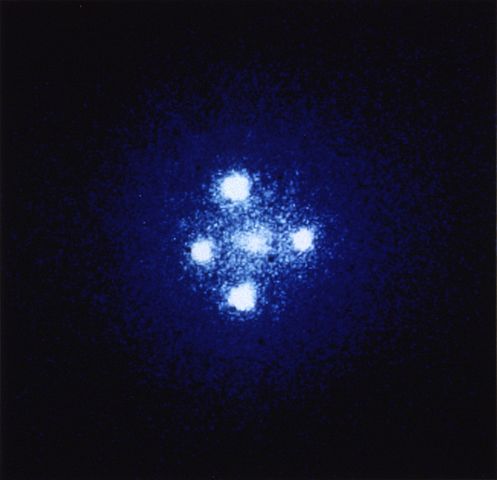 |
This is a file from the Wikimedia Commons. Information from its description page there is shown below.
Commons is a freely licensed media file repository. You can help.
|
Summary
| Description |
The European Space Agency's Faint Object Camera on board NASA's Hubble Space Telescope has provided astronomers with the most detailed image ever taken of the gravitational lens G2237 + 0305 — sometimes referred to as the Einstein Cross. The photograph shows four images of a very distant quasar which has been multiple-imaged by a relatively nearby galaxy acting as a gravitational lens. The angular separation between the upper and lower images is 1.6 arcseconds. |
| Date |
13 September 1990 |
| Source |
http://hubblesite.org/newscenter/archive/releases/1990/20/image/a/ |
| Author |
NASA, ESA, and STScI |
Permission
( Reusing this file) |
| Public domainPublic domainfalsefalse |
 |
This file is in the public domain because it was created by NASA and ESA. NASA Hubble material (and ESA Hubble material prior to 2009) is copyright-free and may be freely used as in the public domain without fee, on the condition that only NASA, STScI, and/or ESA is credited as the source of the material. This license does not apply if ESA material created after 2008 or source material from other organizations is in use.
The material was created for NASA by Space Telescope Science Institute under Contract NAS5-26555, or for ESA by the Hubble European Space Agency Information Centre. Copyright statement at hubblesite.org or 2008 copyright statement at spacetelescope.org. For material created by the European Space Agency on the spacetelescope.org site since 2009, use the {{ ESA-Hubble}} tag. |
|
|
Description from other version: An Einstein Cross reveals the presence of a huge gravitational lens in the distant reaches of the universe. Astronomers discovered this gravitational lens in 1985 using survey maps of the sky obtained with the Hubble Space Telescope (HST). The bright object at the center of the image is a distant galaxy. The four bright objects surrounding it are actually multiple images of a single quasar that lies far beyond the galaxy. The lens was named the Einstein Cross in honour of Albert Einstein, whose relativity theory predicted the phenomena decades before the first gravitational lens was observed in 1979.
File usage
The following pages on Schools Wikipedia link to this image (list may be incomplete):
Schools Wikipedia was created by children's charity SOS Childrens Villages. SOS Childrens Villages is there for the children in our care until they are ready for independence. Sponsoring a child is a great way to help children who need your support.



